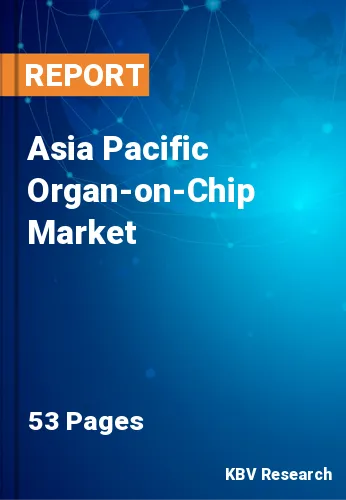The Asia Pacific Organ-on-Chip Market would witness market growth of 31.2% CAGR during the forecast period (2022-2028).
A lab-on-a-chip is a device that combines one or more laboratory operations onto a single chip that handles particles in microfluidic channels. It has been created for more than a decade. Advantages of handling particles on such a small scale include decreased fluid volume utilization (lower reagents costs and less waste), increased mobility of the devices, more process control (owing to faster thermo-chemical reactions), and lower fabrication costs. Moreover, microfluidic flow is completely laminar (i.e., no turbulence).
Consequently, there is minimal mixing between adjacent streams within a single hollow channel. In the field of cellular biology convergence, this uncommon property of fluids has been utilized to study complex cell behaviors, such as cell motility in response to stem cell differentiation, chemotactic stimuli, axon guidance, subcellular propagation of biochemical signaling, and embryonic development.
3D cell-culture models outperform 2D culture systems by fostering greater cell differentiation as well as tissue organization. 3D culture systems are more effective because the flexibility of the ECM gels enables shape variations and cell-cell interactions – traditionally restricted by stiff 2D culture substrates. In spite of this, even the best 3D culture models fail to mimic an organ's cellular properties in many respects, such as tissue-to-tissue interfaces (e.g. epithelium as well as vascular endothelium), spatiotemporal gradients of chemical compounds, and the mechanically active microenvironments.
The Make in India effort of the Indian government is encouraging domestic production of medical devices and lowering patient costs for formerly imported products, such as stents and implants. In India, the legislative environment and regulators must also allow technological interventions, such as the expansion of online pharmacies, with the necessary regulations. Due to the increasing advancements and expanding adoption of novel technologies, the demand for organ-on-chip would also increase. This factor is expediting the growth of the regional market.
The China market dominated the Asia Pacific Organ-on-Chip Market by Country in 2021; thereby, achieving a market value of $56,436.4 Thousands by 2028. The Japan market is registering a CAGR of 30.4% during (2022 - 2028). Additionally, The India market would showcase a CAGR of 32% during (2022 - 2028).
Based on Type, the market is segmented into Lung on chip, Heart on chip, Human on chip, Kidney on chip, Liver on chip, and Intestine on chip. Based on countries, the market is segmented into China, Japan, India, South Korea, Singapore, Malaysia, and Rest of Asia Pacific.
Free Valuable Insights: The Worldwide Organ-on-Chip Market is Projected to reach USD 815.6 Million by 2028, at a CAGR of 30.2%
The market research report covers the analysis of key stake holders of the market. Key companies profiled in the report include AxoSim, Inc., Visikol, Inc., CN Bio Innovations Limited., Elveflow (Elvesys Group), Emulate, Inc., Insphero AG, Mimetas B.V., Nortis Inc., Organovo Holdings, Inc. and TARA Biosystems, Inc.
By Type
By Country
Our team of dedicated experts can provide you with attractive expansion opportunities for your business.

